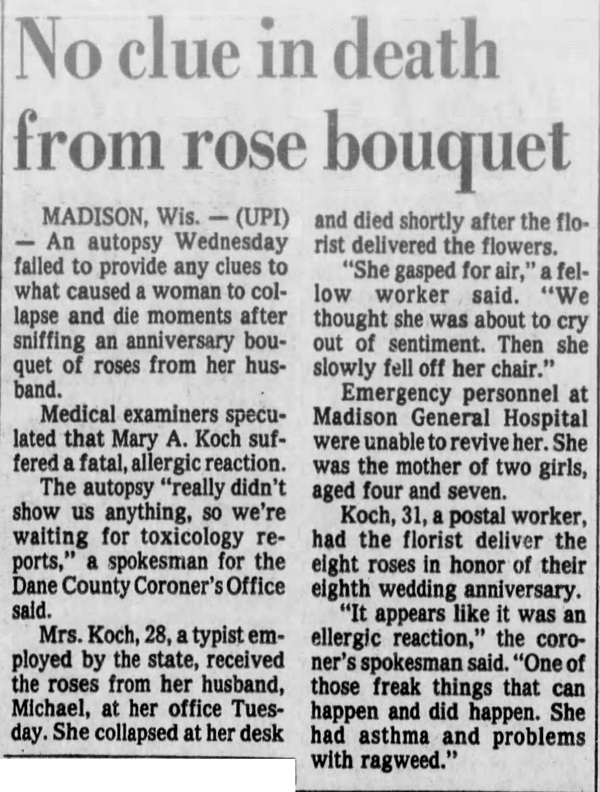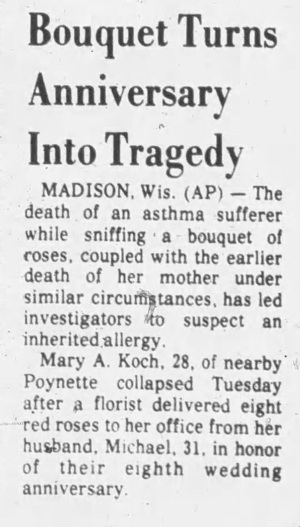Death
Letters From a Living Dead Man
Check out the result of Elsa Barker's "automatic writing" and learn all about the afterlife.Elsa Barker's Wikipedia page.



Posted By: Paul - Thu Aug 08, 2024 -
Comments (0)
Category: Death, Hoaxes and Imposters and Imitators, Supernatural, Occult, Paranormal, 1910s
Recurrent Sudden Death
One of the stranger medical problems a person could suffer from is "recurrent sudden death." In fact, one might think it impossible to suffer from such a problem. However, the term appears fairly often in medical literature. A few examples:
Atlas of Heart Diseases - Arrhythmias : electrophysiologic principles, 1996

New England Journal of Medicine - June 3, 1982
I think, though I'm not entirely sure, that "sudden death" is being used as a synonym for "cardiac arrest." Doctors are aware that the term "recurrent sudden death" sounds absurd. Stedman's Medical Dictionary (2006) advises them not to use it:

And yet the term continues to appear.
Posted By: Alex - Mon Jul 15, 2024 -
Comments (2)
Category: Death, Medicine
Real Life Lassie
Visit page here.

Posted By: Paul - Sun Jul 14, 2024 -
Comments (0)
Category: Death, Lakes, Ponds, Rivers, Streams, Swamps and Other Bodies of Fresh Water, Dogs, 1930s, Courage, Bravery, Heroism and Valor
Man leaves thousands to a stranger, $1 to his wife
When Fred Eggerman died on March 24, 1960, his will left his estate worth approximately $12,000 (about $120,000 in today's money) to the first male child born in Paterson General Hospital on July 2, 1946. He had no idea who that child had been. To his wife he left one dollar.The lucky beneficiary turned out to be high-school student Robert De Boer.
Eggerman's wife filed suit to overturn the will, together with Eggerman's father and brother. They eventually reached a settlement, but it only got them a mere $850. De Boer kept the rest.

Newsday - Apr 22, 1961

New York Daily News - Apr 20, 1961
Based on those details it definitely sounds like Eggerman must a) have been a bit eccentric, and b) have hated his wife. That's how many news articles presented the case. But the article below went into some background details which help to explain what Eggerman did.
For a start, he and his wife had been separated for years and had already worked out a property settlement. So there was no particular reason to leave her more.
As for leaving everything to an unknown child:


Passaic Herald-News - Feb 8, 1962
Posted By: Alex - Fri Jul 12, 2024 -
Comments (0)
Category: Death, Inheritance and Wills, Lawsuits, 1960s
Unlikely Reasons for Murder No. 19


Posted By: Paul - Wed Jul 10, 2024 -
Comments (1)
Category: Death, Fashion, Sports, 1990s
Unlikely Reasons for Murder No. 18


Posted By: Paul - Sat Jun 15, 2024 -
Comments (2)
Category: Death, Europe, United Kingdom, Nineteenth Century
LSD Dangers: The Hotdog
Posted By: Paul - Sun Jun 09, 2024 -
Comments (1)
Category: Anthropomorphism, Death, Drugs, Psychedelic, Food, PSA’s, 1960s
Guess the genuine suicide notes
The 1957 book Clues to Suicide, edited by Edwin Shneidman and Norman Farberow, contains an unusual quiz in the appendix. It presents the reader with 33 pairs of suicide notes. In each pair one of the notes is genuine and one is "simulated." The reader is challenged to guess which is which.The genuine notes were all obtained from the Los Angeles County Coroner's Office. The simulated notes were obtained from "nonsuicidal individuals contacted in labor unions, fraternal groups, and the general community." The individuals were told that by writing the notes they were helping with a scientific study on suicide prevention.
Furthermore, all the note writers (of both the genuine and simulated notes) were "male, Caucasian, Protestant, native-born, and between the ages of twenty-five and fifty-nine."
The authors suggest taking the quiz before reading their book (but not looking at the answers), and then re-taking the quiz after reading it in order to determine if the book has provided "greater perspicacity."
I've pasted three sample pairs below, but I also made a pdf of the entire quiz (with the answer key at the end).
Or you can find the quiz in the book itself which is available to read at the Internet Archive.



More in extended >>
Posted By: Alex - Fri May 24, 2024 -
Comments (2)
Category: Death, Suicide, Quizzes
Woodbury Rand, cat lover
When Boston attorney Woodbury Rand died in 1944, he left $40,000 to his cat Buster. Out of a $1,000,000 estate, that's not particularly unusual. But what made his will odd was that he disinherited anyone whom he felt hadn't properly appreciated Buster.Buster was only 8 years old when Rand died, but he died the following year. Perhaps of a broken heart?


New York Daily News - Aug 6, 1944

New York Daily News - Dec 30, 1945
Posted By: Alex - Sat May 11, 2024 -
Comments (0)
Category: Death, Inheritance and Wills, Cats, 1940s
Death by Roses
Aug 1979: Mary A. Koch collapsed and died while at work soon after receiving a bouquet of roses as a wedding anniversary gift from her husband. Medical examiners suspected she had a fatal, allergic reaction to the roses.
Detroit Free Press - Aug 30, 1979
While the death from roses was strange enough, it turns out that her mother had died earlier "under similar circumstances."

Waterville Morning Sentinel - Sep 1, 1979
Posted By: Alex - Sun May 05, 2024 -
Comments (1)
Category: Death, 1970s

| Who We Are |
|---|
| Alex Boese Alex is the creator and curator of the Museum of Hoaxes. He's also the author of various weird, non-fiction, science-themed books such as Elephants on Acid and Psychedelic Apes. Paul Di Filippo Paul has been paid to put weird ideas into fictional form for over thirty years, in his career as a noted science fiction writer. He has recently begun blogging on many curious topics with three fellow writers at The Inferior 4+1. Contact Us |




